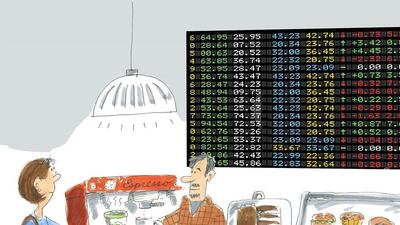There are fortunes to be made from small change, so proclaims the latest digi-money craze.
The idea: invest small amounts of money with every purchase. This is how it works. You link an app to your debit card, and every time you use it, the app rounds up the outlay and puts the difference in an investment portfolio without you noticing.
It’s being sold as a way for those on low incomes, or with very little to spare, to start investing.
It’s called micro-investing. Investments small enough to fit anyone’s budget. It is ‘mindless’ - in that you don’t actively do anything – other than access the app and set up your investor profile based on your values and appetite for risk. That’s it.
The profile you create when setting it up tells the app about the kinds of investments you like. For example, Stash, the company that, weeks ago raised an additional US$40 million in its latest investment round, has bundled exchange traded funds (ETFs) with what they hope will be millennial-enticing names. There’s Trendsetter – investments include social media and retail. Globetrotter – its ETFs invest in companies from over 40 countries; you get the idea.
Acorns, another micro-investment app, has portfolios simply titled to suit risk profile, such as conservative and moderate. While these are available in the US, Moneybox allows UK based-micro investors to put small amounts in tracker funds.
The premise is that the spare change in our lives, that we won’t even notice has gone, is being put to good use.
__________
Read more from Nima Abu Wardeh:
Put together your financial survival kit for losing a spouse
Are you part of the repair revolution?
__________
But is this the best way to utilise cash?
Look at the fees: Stash charges accounts with less than $5,000 a seemingly harmless $1 a month. Then when you hit the $5,000 mark, the charge becomes 0.25 per cent – that's $12.50 a year.
Moneybox's monthly subscription cost is £1 (Dh5). Add to it the platform fee and fund provider fees, and you're looking at a total of 1.28 per cent in fees.
These fees are huge chunks out of returns for those who use the rounding up option of investing. Subscribers can also elect to allocate a specific amount every month, or pay in one-off deposits – which means the monthly fee becomes less of a percentage of that invested but it remains a sizable chunk on returns.
This is probably why apps that promise to invest your change are bringing in big bucks. It's probably why BlackRock, the world's large asset manager, is so interested in micro-investing. But is it the right way to use our spare change?
To help decide, here's a simple overview of micro-investing:
Pros: No account minimum; simple; painless
Instead of saving up, say $100, for one share of a stock or mutual fund, you can buy fractional shares. No matter how small the investment is, it is diversified through an ETF.
Cons: Expensive.
You can only invest in what the parent company has lined up.
The pros outnumber the cons. But do they outweigh them?
I get it, it's sexy to invest and boring to save. But we need to save to invest. So anything that can nudge us into doing both is a good thing.
But let me break it down a bit more: micro-investing with these apps is the digital equivalent of filling your money bank with spare change, and, when full, taking it to the bank. Or in this case, putting it in the EFT the suits your profile at a significant cost.
Is it worth doing?
Call me old-fashioned, I still think that the act of saving money is important. The thought process and habit-forming behaviour that goes with setting physical money aside.
These apps can tip some the way of justifying spending because that's how they end up investing. If they're keen, and have so little, why are they spending on things they don't need in the first place.
In the cold light of day, I have to recommend saving your change in a good old jar, fill it to the brim, then sit and count it out. Put it in an interest-bearing account. And when you have that $1,000 or $3,000, or whatever minimum is needed, invest directly through a low-cost platform.
There is money to be made from our small change. Will it be made by you?
Nima Abu Wardeh is a broadcast journalist, columnist and blogger. Share her journey on finding-nima.com

